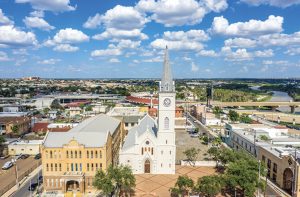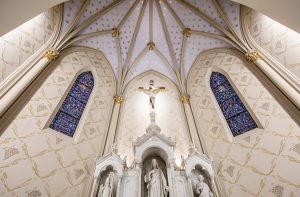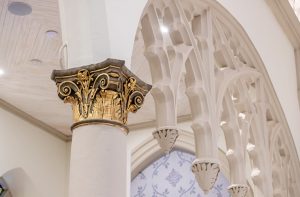Texas Architect Magazine, read full article here.
–Jesse Miller, AIA

The recent rehabilitation of the San Agustín Cathedral in Laredo represents an intriguing combination of history, culture, science, and community and indicates a renewed interest in the city’s downtown.
The existing structure has undergone several additions and renovations since its construction as a church in 1872. Founded in 2000 from portions of the Diocese of Corpus Christi and the Archdiocese of San Antonio, the Diocese of Laredo named the San Agustín church as its cathedral that same year. Soon after, the diocese hired Able City to conduct and implement a master plan that would map out the building’s preservation and maintenance needs.
The church’s designation as a cathedral introduced new programmatic requirements; for instance, San Agustín must now accommodate special masses that take place several times a year. The Chrism Mass, during which oils are consecrated, requires that somewhere between 40 and 50 priests from around the diocese be at the altar simultaneously. To accommodate this, the existing altar needed to grow by 40 percent, which required slightly decreasing the seating capacity of the congregation space.
An important early step in the design process was designating the work on the historic structure as a rehabilitation rather than a renovation. Under a renovation classification, the interior historical standards would have prevented the church from fulfilling the programmatic needs of a cathedral. Mario Pena, AIA, partner and principal at Able City, described the rehabilitation classification as an exercise in balancing programmatic modifications, restoration, and aesthetic enhancement.

Part of the rehabilitation included returning the building and sanctuary closer to their original form by removing nonhistoric additions from the 1950s, including acoustical ceiling tiles and a mechanical CMU enclosure on the roof behind the apse. The mechanical system was reworked to replace the existing air handler units with a larger number of smaller units, which operate at a quieter volume. Condenser units were removed and replaced with an air-chilled water plant in the parking lot, a feat which required boring the chiller lines under the public street.
With the noise from the mechanical system minimized, the architecture team could then focus on vocal clarity. Pena describes how old Catholic churches were built to prioritize music over the voice of the priest. Traditionally, masses were in Latin, so vocal clarity was not the priority; rather, the goal was to enhance the sense of awe instilled by the reverberating music. Today, there is more focus on the intellectual connection between the priest and the congregation. Vocal clarity in echoey sanctuaries can be a challenge. In the San Agustín Cathedral, the solution was to amplify the priest’s voice using speakers directed at the congregation, since sound-dampening strategies would have interfered with the musical resonance.
Part of the master plan process included deep research into iconography with the help of Annie Labatt, who taught at The University of Texas at San Antonio and was director of museums and galleries at Sweet Briar College in Virginia. (Labatt holds a doctorate from Yale University in Byzantine art history.) What resulted is a catalog of imagery for the diocese that includes grapes representing wine and blood, wheat and water (specifically, the Rio Grande that gave birth to the city of Laredo) as symbols for life, and a rose signifying the Virgin of Guadalupe. Able City felt it important to install some of these icons as stencils in portions of the sanctuary. Pena describes this as a sort of time capsule of the church’s thought today, a method of conveying the church’s and the community’s contemporary ideas and reflections.

The cathedral’s layered design process reflects how the architects at Able City shape their practice. According to Pena, the principals of the firm have expanded their expertise with the goal of increasing the impact of their projects: For example, though he was already a licensed architect, Pena later studied to become a certified planner. He describes the firm’s approach as working with clients to create better opportunities — specifically, helping municipalities view capital commitments as community investment. One of the best methods to accomplish this, he says, is engaging the larger community early in the process.
Pena notes that the city of Laredo is thinking comprehensively about capital investment and working to improve key downtown corridors. This is all happening as downtown recovers from COVID-19 and the international border, which was closed to nonessential crossing for 20 months, reopens to Mexican shoppers. With shoppers returning to downtown and parishioners returning to the cathedral, the rehabilitation of downtown Laredo could be poised for growing momentum.
Jesse Miller, AIA, is an architect at Megamorphosis in Harlingen. He lives in Brownsville.

